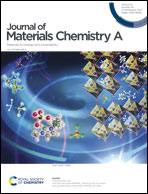Unveiling the mechanism of the photocatalytic reduction of CO2 to formate promoted by porphyrinic Zr-based metal–organic frameworks†
Abstract
A complete picture of the reaction mechanism responsible for the photocatalytic reduction of CO2 into formate promoted by the Zr-based porphyrinic MOF-545 (PCN-222) in acetonitrile/triethanolamine (CH3CN/TEOA) solutions is provided for the first time by combining experimental and computational approaches. Firstly, we combined the metalation of the porphyrin linkers and the synthesis under microwave conditions of nano-sized materials (150–200 nm) to reach one of the highest CO2RR activities under visible light irradiation reported so far for a MOF-based catalyst in terms of formate production (identified in all cases as the sole product), i.e., 6000 μmol g−1 after 4 h for the NanoMOF-545(Fe). A thorough mechanistic study of CO2RR is provided afterwards, which elucidated the respective roles of TEOA, porphyrin linkers and Zr6-nodes. Photophysical measurements of both metalated and unmetalated MOFs excluded the prevailing belief of ligand-to-Zr6 cluster charge-transfer state formation, while bulk photolysis proved that the porphyrinic linkers of the MOF promote the photooxidation of TEOA under catalytic conditions. DFT calculations allowed characterization with atomistic detail of a novel reaction mechanism whereby TEOA˙ radicals generated photochemically at the porphyrinic linkers play the crucial role of transferring a formal hydride to a CO2 molecule activated on a ZrIV center, which acts as a Lewis acid. Notably, this mechanism backed by additional experimental assays explains the experimental activity trends observed upon metalation, on the basis of the ability of the materials to accomplish the photo-oxidation of TEOA. While elucidating the reaction pathways at work in Zr6-based MOFs with chromophore linkers, the findings reported herein pinpoint new mechanistic features capable of rationalizing other light-driven reactions making use of TEOA (or structurally related donors) and ultimately, inspire the bottom-up design of new catalysts and catalytic routes.



 Please wait while we load your content...
Please wait while we load your content...